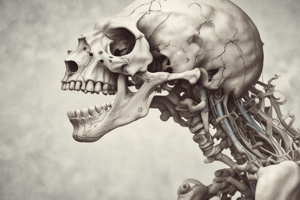Podcast
Questions and Answers
What is the primary cause of the facial and cranial deformities seen in autosomal recessive infantile osteopetrosis?
What is the primary cause of the facial and cranial deformities seen in autosomal recessive infantile osteopetrosis?
- Excessive bone density
- Increased osteoclast activity
- Narrow skull foramina and cranial nerve compression (correct)
- Autosomal recessive inheritance
Which protein defect is primarily responsible for the increased susceptibility to infection in autosomal recessive infantile osteopetrosis?
Which protein defect is primarily responsible for the increased susceptibility to infection in autosomal recessive infantile osteopetrosis?
- Defects in osteoblast-specific proteins
- Defects in osteoclast-specific proteins
- Increased skeletal density
- Granulocytopenia (correct)
What is the most common radiographic feature of autosomal recessive infantile osteopetrosis?
What is the most common radiographic feature of autosomal recessive infantile osteopetrosis?
- Osteomyelitis of the jaws
- Increased skeletal density with defects in metaphyseal remodeling
- Pathologic fractures
- Loss of distinction between cortical and cancellous bone (correct)
Which of the following is a common clinical feature of autosomal recessive infantile osteopetrosis?
Which of the following is a common clinical feature of autosomal recessive infantile osteopetrosis?
What is the primary genetic abnormality underlying autosomal recessive infantile osteopetrosis?
What is the primary genetic abnormality underlying autosomal recessive infantile osteopetrosis?
What is the most common complication of tooth extraction in autosomal recessive infantile osteopetrosis?
What is the most common complication of tooth extraction in autosomal recessive infantile osteopetrosis?
What characterizes osteopetrosis?
What characterizes osteopetrosis?
Which term best describes the failure observed in osteopetrosis?
Which term best describes the failure observed in osteopetrosis?
What is a common clinical feature of autosomal recessive infantile osteopetrosis?
What is a common clinical feature of autosomal recessive infantile osteopetrosis?
Which type of osteopetrosis is usually diagnosed at birth or in early infancy?
Which type of osteopetrosis is usually diagnosed at birth or in early infancy?
What is the estimated frequency of osteopetrosis in the general population?
What is the estimated frequency of osteopetrosis in the general population?
Which of the following is NOT a typical finding in autosomal recessive infantile osteopetrosis?
Which of the following is NOT a typical finding in autosomal recessive infantile osteopetrosis?
What is a common radiographic feature of osteopetrosis in the upper extremity?
What is a common radiographic feature of osteopetrosis in the upper extremity?
Which type of osteopetrosis is characterized by mild to moderate anemia and extramedullary hematopoiesis but rarely bone marrow failure?
Which type of osteopetrosis is characterized by mild to moderate anemia and extramedullary hematopoiesis but rarely bone marrow failure?
In osteopetrosis, why are tooth roots often difficult to visualize on dental radiographs?
In osteopetrosis, why are tooth roots often difficult to visualize on dental radiographs?
What is a characteristic feature of autosomal recessive infantile ('malignant') osteopetrosis?
What is a characteristic feature of autosomal recessive infantile ('malignant') osteopetrosis?
Which bones exhibit increased density in osteopetrosis?
Which bones exhibit increased density in osteopetrosis?
What clinical presentation is often seen in autosomal recessive intermediate osteopetrosis by the end of the first decade?
What clinical presentation is often seen in autosomal recessive intermediate osteopetrosis by the end of the first decade?
Flashcards are hidden until you start studying




